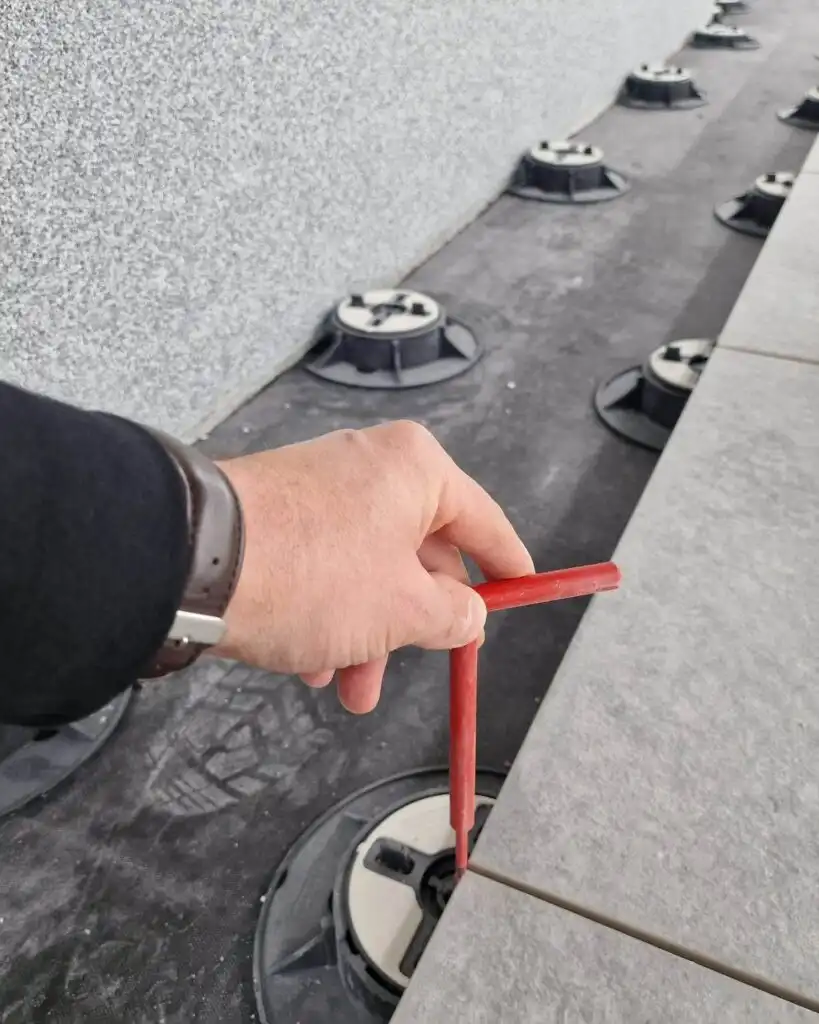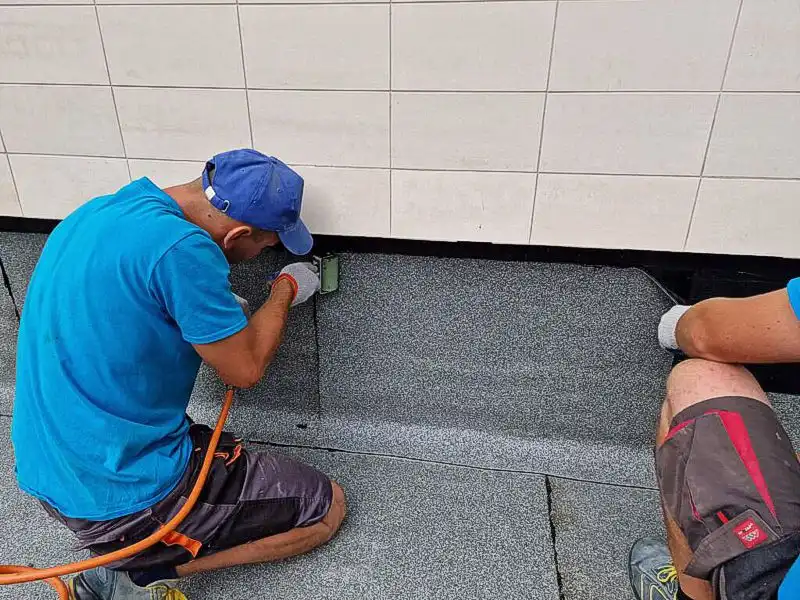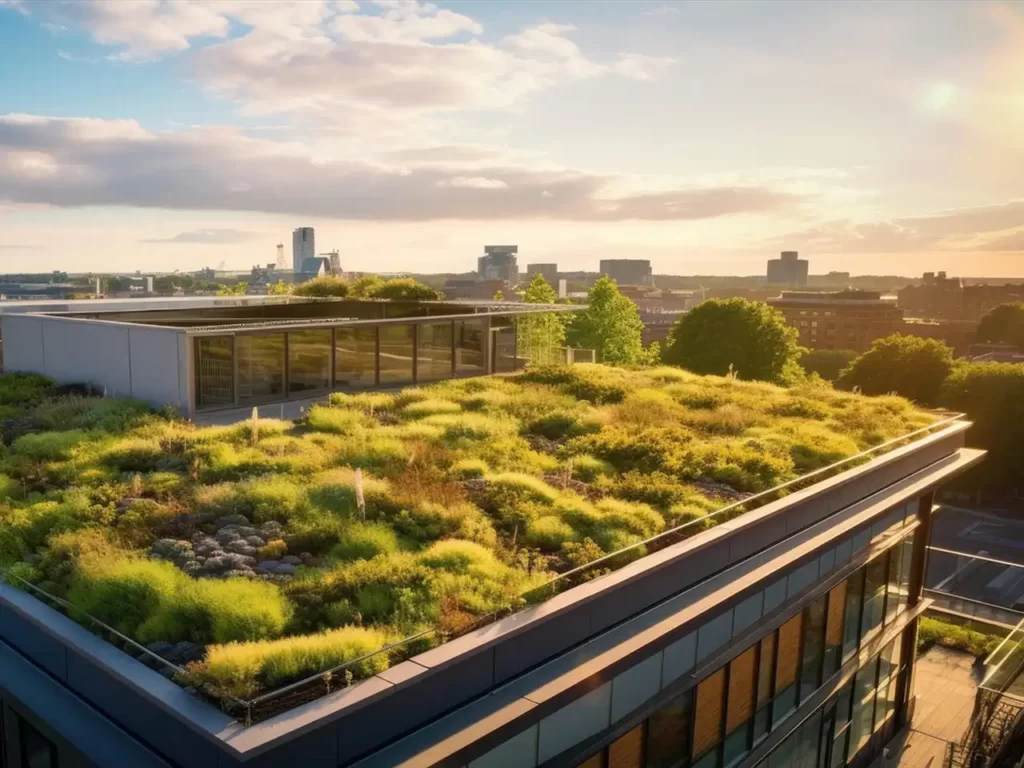Green roofs are increasingly appearing in building designs. An inverted roof system is used for this type of solution. However, it should be noted that a green roof does not necessarily have to have a final finish in the form of green plants and shrubs, but the inverted roof solution itself is one of the best waterproofing solutions for utility terraces as well as roofs.
Why the name inverted roof?
Well, the solution is this, that the waterproofing layer is laid underneath the thermal insulation layer, i.e. the reverse of what happens with traditional roofs. The traditional arrangement of layers on a flat roof, where the thermal insulation is covered by a waterproofing layer, has a major disadvantage: the main protection, usually in the form of a top-cover membrane, which determines the roof's airtightness, is exposed to the direct effects of the weather, thus reducing the insulation's resistance to weathering.
Another disadvantage of such a system is the compensation of water vapour in the layers of the roof insulation, the only possible place for it to evaporate being the system ventilation chimneys, which do not always do their job and thus condensation moisture remaining in the construction of the roof layers is often mistaken for possible leaks.
Waterproofing an inverted roof - step by step
- Prepare the floor slab with a slope formed to allow for self-draining water, not less than 2-3%. Make the slope with WB FAST FLOOR - ready-made quick drying screed
- Level the surfaces and clean off any dirt.
- Prime the substrate with primer WB PRIMER.
- Lay the first layer WB HOT MATE including extension to the façade to a height of approximately 0.6 - 0.7m
- Place second layer WB HOT MATE
- Protect the entire surface with geotextile
- Then lay out a bucket film to allow water to drain easily in layers.
- The next step is to lay thermal insulation with XPS boards of the right density for the pressure.
- Cover the surface of the xps slabs with a geotextile to prevent the penetration of dirt from the pressure layers.
- The simplest covering to form a pressure layer will be a scattering of washed pebble stone of fraction 8/16 or 16/32 .
- As a finishing layer, you can use a convenient concrete or stone slab surface laid on footings or directly on gravel.
Advantages of an inverted roof system with waterproofing
An inverted roof system with waterproofing offers a number of benefits that make it an attractive solution in modern construction. First and foremost, the placement of the waterproofing layer under the thermal insulation layer provides better protection against mechanical damage and the effects of atmospheric factors such as UV radiation and temperature extremes.
This makes the waterproofing more durable and less prone to damage, increasing the life of the entire roof system. In addition, the system prevents condensation in the insulation layer, which improves the energy efficiency of the building.
- The run-off of rainwater from an inverted roof takes place on two levels: part of the water flows into the drainage system from the pavement, and the remaining volume, which penetrates under the insulation to the waterproofing layer, flows down profiled slopes to the drains.
- the possibility of loading the roof with usable loads, as the waterproofing made on the rigid substrate is additionally protected from above by a layer of thermal insulation made from the water-resistant hard XPS material, thus making it possible to create not only green roofs, but also car parks and recreational areas above utility rooms.
- the possibility of quickly and safely checking the tightness of the covering by carrying out a water test. Leakage will always occur at the point of damage to the insulation . In a traditional system, water often leaks at a point away from the damaged insulation.
- very high weather resistance.
These types of roofs are also more environmentally friendly, as they allow for green solutions that improve the microclimate and rainwater retention.
When is it worth opting for an inverted roof with full waterproofing?
Above all, it is worth choosing this solution if you plan to use the roof as a usable space, such as a terrace, roof garden or car park. Thanks to its design, an inverted roof allows safe and efficient use of the roof space, while also providing adequate thermal insulation and protection against water.
An inverted roof with full waterproofing is also an excellent choice in climates exposed to extreme weather conditions. In regions with large temperature fluctuations, heavy rainfall or strong sunlight, this system provides better protection against damage caused by external factors.
The waterproofing placed under the thermal insulation layer is less susceptible to mechanical damage and degradation, resulting in a longer roof life. As a result, an inverted roof with full waterproofing is an investment that increases the longevity and functionality of the building.
CROSS-SECTION OF LAYERS IN AN INVERTED ROOF SYSTEM
Materials needed for inverted roof insulation
- WB Fast Floor.
- WB Primer.
- WB Hot mate.
- XPS insulation.
- Geotextile.
- Bucket film.
Materials for inverted roof finishes
- Washed gravel
- Concrete slabs
If you are not sure how much roofing material you need, you can always use our help. Write or call our technical department.
Implementation of inverted roof waterproofing - condensed knowledge for everyone!
Many times when talking to customers, we explain how important it is in terrace and balcony systems to have vertical insulation on the wall. This is a very important part of the entire system, as it protects the building wall against so-called capillary rising damp. And from this phenomenon, it is a very short way to the formation of harmful fungi in the premises.
The pictures show you the correctly executed transition of the horizontal insulation to the vertical using WB Hot Mate insulation material. Such insulation is carried out in the undercut of the façade up to a height of about 0.6 - 0.7m. and then the missing part of the wall insulation is completed, restoring it to its original structure.



Materials to be used for insulation:
- WB Fast Floor
- WB Primer
- WB Hot mate
- XPS insulation
- Geotextile
- Bucket film
Materials used to finish the roof:
- Washed gravel
- Concrete slabs
-
 WB S line16,00 zł – 27,50 zł
WB S line16,00 zł – 27,50 zł -
 Giant Dark Grey 2.0215,00 zł
Giant Dark Grey 2.0215,00 zł -
 WB Primer Primer 2L55,35 zł
WB Primer Primer 2L55,35 zł -
 WB Hot Mate 5.0270,60 zł
WB Hot Mate 5.0270,60 zł -
 WB Hot Mate 5.2301,35 zł
WB Hot Mate 5.2301,35 zł -
 WB Fast Floor30,75 zł
WB Fast Floor30,75 zł
Remember!
If you are not sure how much material you need for your roof, you can always use our help. Write or call our technical department.
IMPORTANT WHEN WATERPROOFING AN INVERTED ROOF:
VERTICAL INSULATION AS IMPORTANT AS HORIZONTAL INSULATION
Many times when talking to customers, we explain how important it is in terrace and balcony systems to install vertical insulation on the wall. This is a very important part of the entire system, because it protects the building wall against so-called capillary rising damp. From this phenomenon, it is a very short way to the formation of fungi that are harmful to health. In the pictures we show you a correctly installed horizontal insulation transition to the riser pipe using WB Hot Mate insulation material. This insulation is carried out in the undercut of the façade up to a height of approx. 0.6 - 0.7 m. and then the missing part of the wall insulation is completed, restoring it to its original structure.




